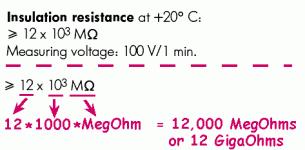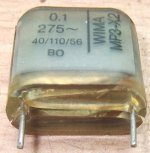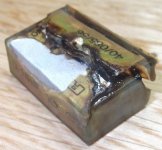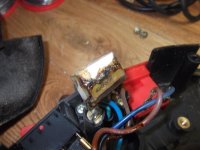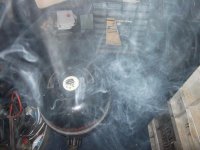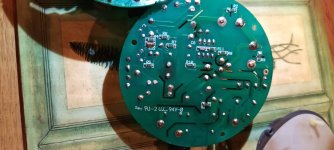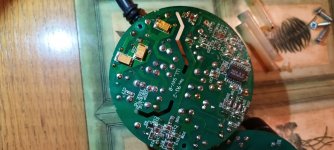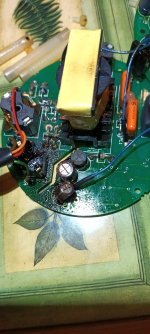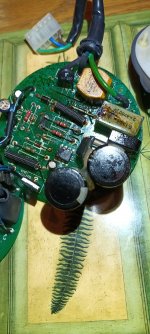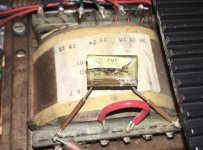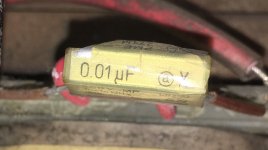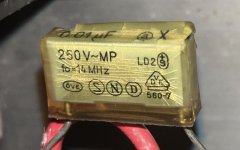In the sixties a series of epoxy dipped capacitors made by WIMA were notorious for cracks and following isolation leakage. You could find them in all tube electronic stuff like radios, taperecorders etc. Used as coupling/-decoupling caps most of the time the were not exposed to direct ac-line and so failed to show these entertaining fireworks the Rifas were famous for later on. . It should be noted that WIMA nowadays do not produce any dipped caps anymore, all their caps are canned now.
. It should be noted that WIMA nowadays do not produce any dipped caps anymore, all their caps are canned now.
Last edited:
Probably even more worrying than X caps catching fire are the Y capacitors of similar technology and aspect, also made by Rifa.
If one of those fail, especially in class II devices where they connect the mains to the output GND, it could result in the electrocution of the user (or anybody else)
If one of those fail, especially in class II devices where they connect the mains to the output GND, it could result in the electrocution of the user (or anybody else)
Before laughing you should read what you are laughing about. Then you could discover that 10^3 MegOhm = 10 GigaOhms.Hahahahahah
Check the insulation resistance measurement spec....
12 MegOhm Insulation resistance, measured at 100V does not seem to be very good, at all.
And btw - leakage current of X2 caps is not that issue
Hahahahahah...
Yes, the datasheet is unnecessarily confounding.
Attachments
Before laughing you should read what you are laughing about. Then you could discover that 10^3 MegOhm = 10 GigaOhms.
And btw - leakage current of X2 caps is not that issue
Yes, the datasheet is unnecessarily confounding.
Before laughing?
Excuse me Bugs Bunny, this is my area of expertise at work...
No professional company will mix exponents and units in such a way.
But yes I misread the incredibly poorly executed datasheet.
And, well, in my working experience, such items usually pass a far higher IR value, more like 50G.
Last edited:
Several weeks ago I brokered a Linn pre-amplifier (KAIRN) with Brilliant SMPS for a friend. As a precaution I replaced the electrolytic capacitors, but not the RIFA X2, because I don't know about the bad reliability in general for this version at that time.
The consequence was a dissatisfied user and a lot of complaint work regarding cleaning of the two SMPS assemblies including the PCB's. Extremely annoying. The seventh image shows the same RIFA X2 capacitor than those from the last three images.
The consequence was a dissatisfied user and a lot of complaint work regarding cleaning of the two SMPS assemblies including the PCB's. Extremely annoying. The seventh image shows the same RIFA X2 capacitor than those from the last three images.
Attachments
-
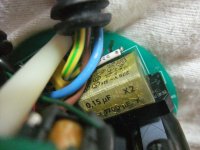 Linn Brilliant SMPS-RIFA X2-II.jpg288.1 KB · Views: 768
Linn Brilliant SMPS-RIFA X2-II.jpg288.1 KB · Views: 768 -
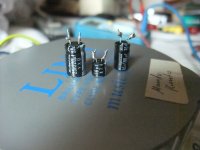 Linn Brilliant SMPS-replaced caps.jpg259.6 KB · Views: 171
Linn Brilliant SMPS-replaced caps.jpg259.6 KB · Views: 171 -
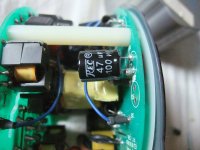 Linn Brilliant SMPS-VI.jpg278.3 KB · Views: 170
Linn Brilliant SMPS-VI.jpg278.3 KB · Views: 170 -
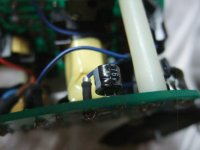 Linn Brilliant SMPS-VII.jpg198.3 KB · Views: 197
Linn Brilliant SMPS-VII.jpg198.3 KB · Views: 197 -
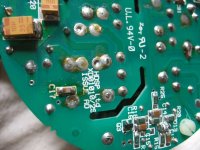 Linn Brilliant SMPS-PCB-II.jpg255.1 KB · Views: 210
Linn Brilliant SMPS-PCB-II.jpg255.1 KB · Views: 210 -
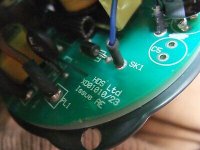 Linn Brilliant SMPS-PCB-I.jpg20.3 KB · Views: 231
Linn Brilliant SMPS-PCB-I.jpg20.3 KB · Views: 231 -
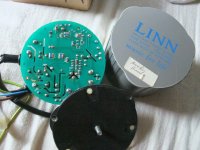 Linn Brilliant SMPS-II.jpg302.2 KB · Views: 279
Linn Brilliant SMPS-II.jpg302.2 KB · Views: 279 -
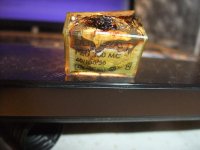 DSCF7424.jpg984.4 KB · Views: 165
DSCF7424.jpg984.4 KB · Views: 165 -
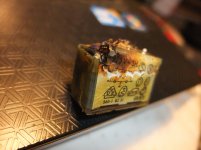 DSCF7428.jpg979.7 KB · Views: 169
DSCF7428.jpg979.7 KB · Views: 169 -
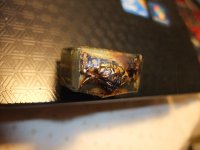 DSCF7426.jpg966.9 KB · Views: 152
DSCF7426.jpg966.9 KB · Views: 152
Last edited:
You have never experienced one go off in a vacuum cleaner.
The last photo is one that blew up without any smoke as no power was applied and it had never even been soldered into a board.
They definitely time out like ticking time bombs.
The last photo is one that blew up without any smoke as no power was applied and it had never even been soldered into a board.
They definitely time out like ticking time bombs.
Attachments
Once I was playing with an old 16mm film projector. A few minutes after powering it off I heard a strange sputtering sound. There was a wax motor capacitor that was leaky and got hot enough to build up pressure and blow liquid wax out of the enclosure. A few more minutes of power and it would have probably exploded.
Someone asked me to repair an instrument amp or EQ (can’t recall) and one of the green epoxy dipped caps blew its foil guts inside out.
Someone asked me to repair an instrument amp or EQ (can’t recall) and one of the green epoxy dipped caps blew its foil guts inside out.
More worrying than any material damage is the fact that the X cap is part of a combo including Y caps;
A lethal combination: even if the Y caps are more robust (or less fragile) than the X cap, they could fail by proxy, if the Xcap burns and explode
Exact. These IEC inlet sockets under
https://docs.rs-online.com/56ea/0900766b81523dc2.pdf
with integrated x- and y caps are also a very unfavorable solution because these are usually always connected to the mains even after the amp device has been switched off.
Furthermore, you cannot open these parts for the purpose of visual inspection or for the purpose of replace.
Sometimes integrated main fuse blows - at first glance for no apparent reason, particularly if the IEC inlet was embedded in shrink rubber (often to observe on Linn audio components).
That's why I always remove such versions for versions without integrated filter parts.
Last edited:
Can it be repaired
Hello all the units I have seen look quite clean. Has mine gone too far
Hello all the units I have seen look quite clean. Has mine gone too far
Attachments
same problem as mentioned in post #28. Desolder big parts and cables, clean the PCB's carefully, and replace also additional all electrolytic caps (small voltages by 63V versions).
check out this threads in this case:
Linn Brilliant SMPS - naked! - pink fish media
and post #5 under
Linn "LINTO" MC Preamp Schematic without SMPS - Schematic for SMPS wanted
last PDF
check out this threads in this case:
Linn Brilliant SMPS - naked! - pink fish media
and post #5 under
Linn "LINTO" MC Preamp Schematic without SMPS - Schematic for SMPS wanted
last PDF
IEC Inlet C14 sockets with integrated RFI filters like
Schaffner introduces a new series of RFI filters with IEC Inlet C14 or C20 - What's New in Electronics
and
KFS - IEC Appliance Inlet C14 with Filter
are also a great issue, because in most cases the main switch is behind this filter.
This means, the integrated capacitors (probably very small and cheap versions) are even after "switch off" of the device permanently connected to the mains (e. g. the case on several audio components from Linn and Passlabs - check out post #19 under
Pass X250 repair
image No 4+5).
In such cases it is better either replace the C14 inlet socket or using an outdoor main switch and shorting the internal mains switch.
Schaffner introduces a new series of RFI filters with IEC Inlet C14 or C20 - What's New in Electronics
and
KFS - IEC Appliance Inlet C14 with Filter
are also a great issue, because in most cases the main switch is behind this filter.
This means, the integrated capacitors (probably very small and cheap versions) are even after "switch off" of the device permanently connected to the mains (e. g. the case on several audio components from Linn and Passlabs - check out post #19 under
Pass X250 repair
image No 4+5).
In such cases it is better either replace the C14 inlet socket or using an outdoor main switch and shorting the internal mains switch.
Recently bought this Tandberg TR2060 off eBay.
When I've got it it made popping sounds and then the protection relay would kick in. Removed the lid and noticed loads of rust on the push buttons springs (previous owner lived by the sea) so I thought it must be the rust inside the tape / speaker slector button contacts. I've proceeded to removing them but then I've noticed this Rifa PME271M 0.01uf fo-14MHz 250V on the power adaptor that was blown off. Now I'm thinking this might be the reason the protection relay would kick in.
Had a look online and was not able to find the exact same specs.
https://www.ebay.co.uk/itm/134072668614?var=433515813863
This one seems to be ideal but it's PME 271Y and not "M". Does it matter?
https://www.ebay.co.uk/itm/302811692750?hash=item4680fbbece:g:hoYAAOSwzq...
This one is the correct number model but the voltage rating is 275v instead of 250v
https://www.ebay.co.uk/itm/371162677948?hash=item566b0502bc:g:e78AAOSwev...
https://www.ebay.co.uk/itm/165494642493?hash=item26883fd73d:g:bRkAAOSwcs...
This again "suppression class Y"
Does Y or M matter? Does the MHz rating matter?
As I understand from this thread Rifa capacitors are not that reliable.
I would be really grateful if someone could drop me a link for a suitable replacement for this cap.
When I've got it it made popping sounds and then the protection relay would kick in. Removed the lid and noticed loads of rust on the push buttons springs (previous owner lived by the sea) so I thought it must be the rust inside the tape / speaker slector button contacts. I've proceeded to removing them but then I've noticed this Rifa PME271M 0.01uf fo-14MHz 250V on the power adaptor that was blown off. Now I'm thinking this might be the reason the protection relay would kick in.
Had a look online and was not able to find the exact same specs.
https://www.ebay.co.uk/itm/134072668614?var=433515813863
This one seems to be ideal but it's PME 271Y and not "M". Does it matter?
https://www.ebay.co.uk/itm/302811692750?hash=item4680fbbece:g:hoYAAOSwzq...
This one is the correct number model but the voltage rating is 275v instead of 250v
https://www.ebay.co.uk/itm/371162677948?hash=item566b0502bc:g:e78AAOSwev...
https://www.ebay.co.uk/itm/165494642493?hash=item26883fd73d:g:bRkAAOSwcs...
This again "suppression class Y"
Does Y or M matter? Does the MHz rating matter?
As I understand from this thread Rifa capacitors are not that reliable.
I would be really grateful if someone could drop me a link for a suitable replacement for this cap.
Attachments
It looks fine but shows as out of stock for me. These caps are not critical apart from having to be safety rated.
You can just snip the old one out for now, it doesn't need it to work. M can mean 20% tolerance (not critical here) and MP could be Metalized Polyester (the type).
https://cpc.farnell.com/vishay/bfc233620103/capacitor-class-x2-0-01uf/dp/CA07137
You can just snip the old one out for now, it doesn't need it to work. M can mean 20% tolerance (not critical here) and MP could be Metalized Polyester (the type).
https://cpc.farnell.com/vishay/bfc233620103/capacitor-class-x2-0-01uf/dp/CA07137
- Home
- Design & Build
- Parts
- Cracked/exploded Evox Rifa Metallized Paper X2 Capacitors - What Deficiencies?
